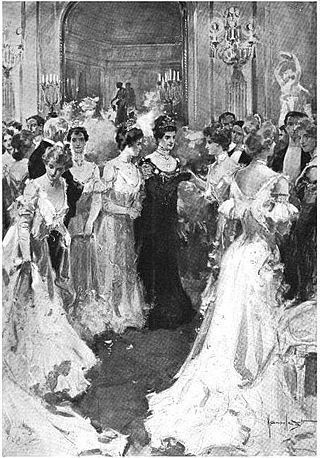
Leisure has often been defined as a quality of experience or as free time. Free time is time spent away from business, work, job hunting, domestic chores, and education, as well as necessary activities such as eating and sleeping. Leisure as an experience usually emphasizes dimensions of perceived freedom and choice. It is done for "its own sake", for the quality of experience and involvement. Other classic definitions include Thorstein Veblen's (1899) of "nonproductive consumption of time." Free time is not easy to define due to the multiplicity of approaches used to determine its essence. Different disciplines have definitions reflecting their common issues: for example, sociology on social forces and contexts and psychology as mental and emotional states and conditions. From a research perspective, these approaches have an advantage of being quantifiable and comparable over time and place.

A trophy wife is a wife who is regarded as a status symbol for the husband. The term is often used in a derogatory or disparaging way, implying that the wife in question has little personal merit besides her physical attractiveness, requires substantial expense for maintaining her appearance, is often unintelligent or unsophisticated, does very little of substance beyond remaining attractive, and is in some ways synonymous with the term gold digger. A trophy wife is typically relatively young and attractive, and may be a second, third or later wife of an older, wealthier man. A trophy husband is the male equivalent.

Thorstein Bunde Veblen was an American economist and sociologist who, during his lifetime, emerged as a well-known critic of capitalism.

Consumerism is a social and economic order that encourages the acquisition of goods and services in ever-increasing amounts. With the Industrial Revolution, but particularly in the 20th century, mass production led to overproduction—the supply of goods would grow beyond consumer demand, and so manufacturers turned to planned obsolescence and advertising to manipulate consumer spending. In 1899, a book on consumerism published by Thorstein Veblen, called The Theory of the Leisure Class, examined the widespread values and economic institutions emerging along with the widespread "leisure time" at the beginning of the 20th century. In it, Veblen "views the activities and spending habits of this leisure class in terms of conspicuous and vicarious consumption and waste. Both relate to the display of status and not to functionality or usefulness."

In sociology and in economics, the term conspicuous consumption describes and explains the consumer practice of buying and using goods of a higher quality, price, or in greater quantity than practical. In 1899, the sociologist Thorstein Veblen coined the term conspicuous consumption to explain the spending of money on and the acquiring of luxury commodities specifically as a public display of economic power—the income and the accumulated wealth—of the buyer. To the conspicuous consumer, the public display of discretionary income is an economic means of either attaining or of maintaining a given social status.

A Veblen good is a type of luxury good for which the demand increases as the price increases, in apparent contradiction of the law of demand, resulting in an upward-sloping demand curve. The higher prices of Veblen goods may make them desirable as a status symbol in the practices of conspicuous consumption and conspicuous leisure. A product may be a Veblen good because it is a positional good, something few others can own.

The Theory of the Leisure Class: An Economic Study of Institutions (1899), by Thorstein Veblen, is a treatise of economics and sociology, and a critique of conspicuous consumption as a function of social class and of consumerism, which are social activities derived from the social stratification of people and the division of labor; the social institutions of the feudal period that have continued to the modern era.

In sociology and anthropology, symbolic capital can be referred to as the resources available to an individual on the basis of honor, prestige or recognition, and serves as value that one holds within a culture. A war hero, for example, may have symbolic capital in the context of running for political office.
The trickle-down effect is a model of product adoption in marketing that affects many consumer goods and services.
Institutional economics focuses on understanding the role of the evolutionary process and the role of institutions in shaping economic behavior. Its original focus lay in Thorstein Veblen's instinct-oriented dichotomy between technology on the one side and the "ceremonial" sphere of society on the other. Its name and core elements trace back to a 1919 American Economic Review article by Walton H. Hamilton. Institutional economics emphasizes a broader study of institutions and views markets as a result of the complex interaction of these various institutions. The earlier tradition continues today as a leading heterodox approach to economics.
Positional goods are goods valued only by how they are distributed among the population, not by how many of them there are available in total. The source of greater worth of positional goods is their desirability as a status symbol, which usually results in them greatly exceeding the value of comparable goods.
Productive and unproductive labour are concepts that were used in classical political economy mainly in the 18th and 19th centuries, which survive today to some extent in modern management discussions, economic sociology and Marxist or Marxian economic analysis. The concepts strongly influenced the construction of national accounts in the Soviet Union and other Soviet-type societies.

Anti-consumerism is a sociopolitical ideology that is opposed to consumerism, the continual buying and consuming of material possessions. Anti-consumerism is concerned with the private actions of business corporations in pursuit of financial and economic goals at the expense of the public welfare, especially in matters of environmental protection, social stratification, and ethics in the governing of a society. In politics, anti-consumerism overlaps with environmental activism, anti-globalization, and animal-rights activism; moreover, a conceptual variation of anti-consumerism is post-consumerism, living in a material way that transcends consumerism.
The Theory of Business Enterprise is an economics book by Thorstein Veblen, published in 1904, that looks at the growing corporate domination of culture and the economy.

The Thorstein Veblen Farmstead is a National Historic Landmark near Nerstrand in rural Rice County, Minnesota, United States. The property is nationally significant as the childhood home of Thorstein B. Veblen (1857-1929), an economist, social scientist, and critic of American culture probably best known for The Theory of the Leisure Class, published in 1899.

High society, sometimes simply society, is the behavior and lifestyle of people with the highest levels of wealth and social status. It includes their related affiliations, social events and practices. Upscale social clubs were open to men based on assessments of their ranking and role within high society. In American high society, the Social Register was traditionally a key resource for identifying qualified members. For a global perspective, see upper class. The quality of housing, clothing, servants and dining were visible marks of membership.
Workmanship is a human attribute relating to knowledge and skill at performing a task. Workmanship is also a quality imparted to a product. The type of work may include the creation of handcrafts, art, writing, machinery and other products.
Conspicuous conservation describes consumers who purchase environmentally friendly products in order to signal a higher social status.
Paradox of Prosperity is a term used widely in many instances in economics, social theory and general commentary. In inter-generational analysis, Professor Gilbert N. M. O. Morris defines the term through an analysis of the familial dynamics and social proclivities of what Tom Brokaw has called the "Greatest Generation". Morris argues that:
"A paradox of prosperity is revealed and shown to be stable in the cycles of economic advancement between generations. I would put the matter this way: If one accepts, for example, that Mr. Brokaw's 'Greatest Generation' were characterised by prudence, diligence, and patriotism in deed rather than word, that very generation produced its opposite in the generation that followed it. That is to say, I have found it repeated across the ages and across cultures, that the more diligent a previous generation, as a natural propensity, the more licentious the generation that follows. Invariably therefore, the generation that exhibits the more cogent properties of character for the best sort of citizenship fails to produce a generation of the same or similar characteristics."
Guilt-free consumption (GFC) is a pattern of consumption based on the minimization of the sense of guilt which consumers incur when purchasing products or commercial services.










